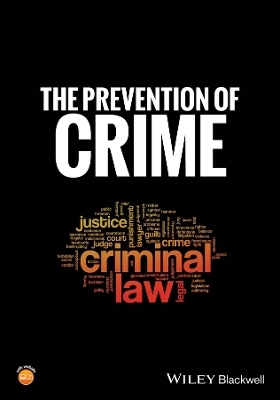
The Prevention of Crime
Wiley-Blackwell (Verlag)
978-1-394-15335-0 (ISBN)
The Prevention of Crime offers a comprehensive yet easy-to-understand overview of crime prevention strategies, such as programs and practices guided by life-course developmental theories of crime, situational crime prevention, law enforcement practices and policies, and correctional interventions. Containing the most up-to-date and accurate information about “what works” in crime prevention, this unique textbook introduces students to the public health and prevention science approaches to addressing the causes of crime, with a focus on prevention-oriented, community-based interventions. Throughout the text, the authors emphasize the importance of using high-quality scientific methodologies to identify effective and ineffective interventions that are based on theory, provide expert insights on practical issues relating to crime prevention in communities, and discuss how practitioners can effectively implement a range of crime prevention strategies.
Incorporating recent advances and emerging research in the field, the second edition of The Prevention of Crime contains new and updated coverage of developments in criminological theory and evaluation methods, efforts to avoid and correct discriminatory crime prevention practices, understand how and why communities make adaptations to evidence-based interventions (EBI), strategies to investigate and communicate the impact of EBIs on different populations (including members of racial/ethnic minority groups), and more. This edition includes new links to relevant research and internet resources, additional real-world examples, updated crime statistics, and information on recent changes in EBI registries that list crime prevention interventions.
Describes effective interventions that have been developed, tested, and used in the United States and internationally
Demonstrates the relationship between criminological theories, research, and practice
Discusses the practical challenges of implementing crime prevention strategies and policies
Corrects misconceptions about widely-used prevention models shown to be ineffective in reducing crime
Draws from cutting-edge conceptual frameworks and the latest research in prevention science and crime prevention
Written to be accessible to students without formal training in research methods, The Prevention of Crime, Second Edition, is an excellent textbook for undergraduate and graduate programs in criminology, criminal justice, and prevention science programs, as well as courses on psychology, public health, sociology, and social work.
Abigail A. Fagan is a Professor in the Department of Sociology and Criminology & Law at the University of Florida. Her research examines the causes and prevention of juvenile delinquency and drug use and how scientific knowledge can be successfully translated into effective programs and practices for preventing crime and delinquency. She is the former President of the Society for Prevention Research and the author of two books and nearly 100 articles in leading criminology, psychology, and public health journals. Delbert Elliott is a Distinguished Professor Emeritus at the Institute of Behavioral Science (IBS), University of Colorado Boulder. He was the Founding Director of The Center for the Study and Prevention of Violence and the Blueprints for Healthy Youth Development Initiative at IBS. He served as Principal Investigator for the first nine waves of the National Youth Survey and chaired the Criminal and Violent Behavior Review Committee (NIMH). Elliott was Science Editor of the U.S. Surgeon General’s Report on Youth Violence and is a past President and Fellow of The American Society of Criminology.
Preface ix
Acknowledgments xii
About the Companion Website xiv
Section I: Introduction to Crime Prevention
Chapter 1: The Goals and Logic of Crime Prevention
Chapter 2: A Brief History of Crime Prevention
Section II: The Foundations of Prevention Science
Chapter 3: Designing Prevention Interventions and the Science and Practice of Crime Prevention
Chapter 4: Evaluation Science
Chapter 5: Establishing a Standard for Judging Intervention Effectiveness
Section III: What Works to Prevent Crime?
Chapter 6: Situational and Legal Crime Prevention Programs, Practices, and Policies
Chapter 7: Contextual Interventions
Chapter 8: Individual- level Crime Prevention: Preventing the Onset of Crime
Chapter 9: Individual-level Crime Prevention: Reducing the Continuity of Offending
Section IV: Crime Prevention in Practice
Chapter 10: Selecting and Implementing Effective Crime Prevention Practices, Programs, and Policies
Chapter 11: Dissemination and Implementation Science: Taking Effective Crime Prevention Programs, Practices, and Policies to Scale
Chapter 12: The Future of Crime Prevention
Glossary 453
Author Index 464
Subject Index 482
| Erscheinungsdatum | 21.02.2024 |
|---|---|
| Sprache | englisch |
| Gewicht | 1030 g |
| Themenwelt | Recht / Steuern ► Strafrecht ► Kriminologie |
| Sozialwissenschaften ► Soziologie | |
| ISBN-10 | 1-394-15335-X / 139415335X |
| ISBN-13 | 978-1-394-15335-0 / 9781394153350 |
| Zustand | Neuware |
| Haben Sie eine Frage zum Produkt? |
aus dem Bereich



